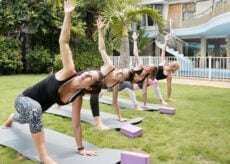Jumpstart 2021 with This 30-Day Home Workout Plan

If you’re like most folks, the holidays (or even much of the entire year) may have gotten the better of you. Now, you’re looking for a good home workout plan, so you can start the New Year off right. Well, you’re in luck because we have a 30-day home workout plan that can help get you back on track and seeing results quickly. Read on to find out more…
What Makes Up a Good Workout Plan?
A good workout plan is more than just a workout routine. A “good” plan should be comprehensive and include resistance training and some form of cardiovascular fitness training as well as stretching, flexibility, and mobility movements.
In addition to the above, you should couple a good fitness plan with a proper diet plan for your goals. Keeping your nutrition on point will go a long way toward revealing your progress and getting you to a healthier place across the board.
Lastly, it’s important to address the mental aspects of your fitness plan as well. Decide what you want, why you want it, and how you’re going to get there. Track your progress and celebrate your wins!
In today’s 30-day home workout plan, we cover the following:
- Getting Started
- Your 30-Day Workout Plan
- Week 1 Program
- Week 2 & 3 Program
- Week 4 Program
- Body Part Exercise Guide
- What Kind of Cardio Should You Be Doing?
- And Diet is Key
30-Day Home Workout Plan: How to Get Started
Getting the Right Equipment
You may or may not have access to a gym, but chances are good that, more often than not, getting in a workout might have to take place at home. With that said, besides using just your body weight, there are a few inexpensive pieces of equipment you can use to help you get a great at-home workout!
4 Keys to Victory
When embarking on any new plan, setting yourself up for success is crucial. Pay special attention to these areas:
- Your kitchen—if you tend to have a lot of snacks and foods that are “not on your plan” around the house, you’ll be doing yourself a huge favor if you get rid of them.
- Your exercise program—make sure you’re ready to go with an appropriate area in your home dedicated to your exercise plan. If you’re going to incorporate any equipment, like resistance bands or dumbbells, make sure you have them handy and ready to go.
- Your goals along with your whys—this step is so important, it should have been listed first. Before you embark on any program, it’s important to know what you want and why you want it.
- Your support system—having support is also vital. Make sure you get family and friends on board with your plan. Maybe some of them will even want to join you on your home workout mission! It will be easier to stick with the program, especially on the days when you’re just not feeling it, if you have some other folks who are along for the journey with you. If you’re struggling to get those in your circle on board, then consider expanding your circle online by joining our wonderful and supportive BioTRUST VIP group.
Your 30-Day Workout Plan
Basically, your plan will consist of a combination of both resistance training and cardiovascular training. A great way to get a jumpstart on your fitness is to combine the two, engaging in both throughout the week. Below, we outline a plan of attack that you can use to get fit quickly.
Cardio
Your cardio program can take place indoors or outdoors, or it can be a combination of both, but either way, it has to happen.
Warming Up Is Important, too!
You’ll also want to ensure that you warm up your muscles before you get started on your resistance training routine. Here are a couple of examples you can use. Perform one or more of these exercises for about five minutes.
- Jump rope
- Bodyweight squats
- Run the stairs in your house
- Arm circles
- Jog in place or around your house
Week 1 Program
Week 1 Resistance Training
During Week 1, you’ll be working your full body three times a week. It’s essential to have at least one full day in between your resistance training workouts. On these “rest” days, you can do cardio.
For this week, you’ll work each body part during every resistance training workout. After a five-minute warmup, pick one exercise for each body part listed below from the list of exercises (see list at the end of this article) and do 15 repetitions for each exercise with 2 minutes of rest between each set.
- Chest
- Shoulders
- Triceps
- Back
- Biceps
- Legs
- Abs
Week 1 Cardio Schedule
You’ll be working your full body three times a week, and you’ll do cardio twice a week. An example of this type of setup might look like this:
- Monday—Full Body Resistance Training
- Tuesday—Cardio
- Wednesday—Full Body Resistance Training
- Thursday—Cardio
- Friday—Full Body Resistance Training
- Saturday, Sunday—Rest Days or Active Rest
BREAKING: Forget Taking Collagen, Try This 21-Second Trick for Healthier Skin & Hair Instead
Week 2 & 3 Program
Congratulations on completing Week 1! Now, let’s move to Weeks 2 and 3. During Week 2, we’ll progress to working the upper body twice and the lower body once, with cardio on the days in-between. During Week 3, we’ll continue on the same theme but working the lower body twice and the upper body once.
During Weeks 2 and 3, pick 2 exercises for each body part and do 1 set of each (unless only 1 is listed, then do it twice or choose your own) for 15 repetitions. Rest for one minute between sets with a two-minute rest period between body parts.
UPPER BODY
- Chest
- Shoulders
- Triceps
- Back
- Biceps
LOWER BODY
- Legs
- Calves
- Abs
Week 4 Program
And, during the final phase of this 30-day at-home workout plan, we’ll move to “body part training.” This means that you’ll work body parts separately (combining ones that are easily worked with each other). Mainly, you’ll do resistance training four days a week with three days of cardio in-between. Pick two exercises for each body part from the list below or find your own. Do 3 sets of each exercise for 10 – 15 repetitions. Here’s an example week-long schedule:
- Monday: Chest/Shoulders
- Tuesday: Back/Abs
- Wednesday: Cardio
- Thursday: Biceps/Triceps
- Friday: Legs/Abs
- Saturday or Sunday: Cardio
Body Part Exercise Guide
CHEST:
Pushups—You can either do these the usual way or, if you’re not quite strong enough to do a regular pushup (which a lot of us aren’t), then you can do pushups from your knees. Start by kneeling on your hands and knees. Your palms will be face down on the floor, lined up under your shoulders or slightly wider.
Straighten your legs and get up on your toes. While keeping your back and legs straight, bend at the elbows and lower your torso toward the ground. Once your chest is close to the ground, push back up through your elbows while straightening your arms.
Note: You can also vary the width of your hand placement during pushups to target different areas of the chest.
Feet Elevated Pushups—with your hands on the ground under your shoulders, place your legs on the stability ball/platform behind you. Your back and legs should form a straight line. Bend at the elbows to lower your upper body toward the ground (while keeping your legs balanced on the ball), keeping the core tight. Push back up to the start to complete one pushup.
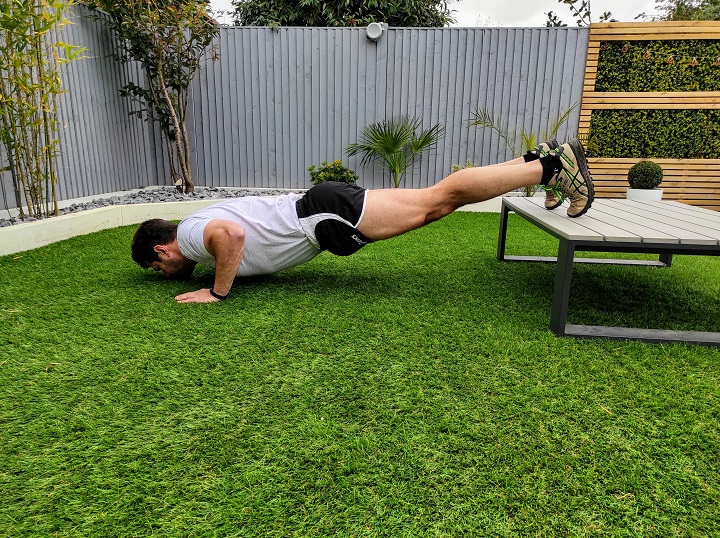
TRICEPS:
Dips—you can use a chair, stair, bench, or even a low countertop for this exercise. Sit on the edge of the chair and place your palms on the edge of the seat. Your hands should be close to each side of your hips. Slide forward until your hips are off the edge and you are supported by your arms. Your legs will be bent or straight out in front of you. (The straighter your legs, the more difficult the exercise.) Slowly lower your hips by bending your arms until your upper arms are at a 45-degree angle. Push back up through your arms to bring your hips back to the seated position.
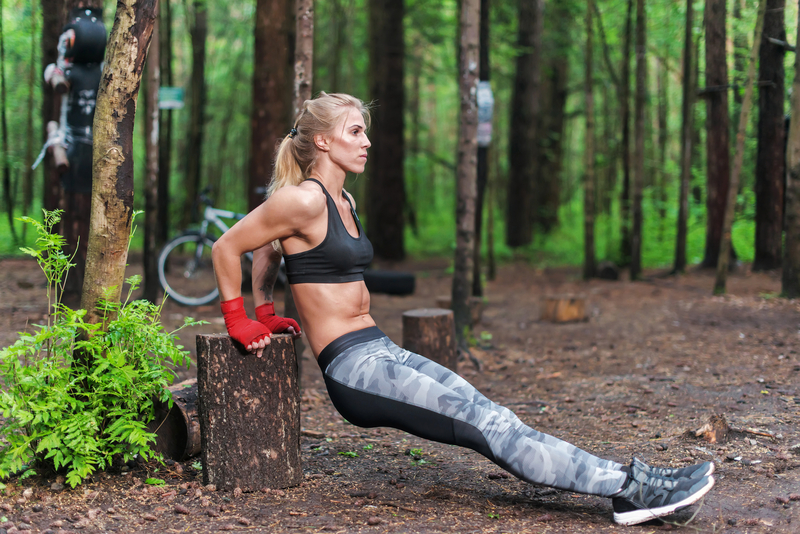
Triceps Kickbacks—with a light dumbbell in your right hand, bend over at the waist, and put your left hand on your left thigh, ball, bench, or couch (to balance). Bring your right upper arm upwards until it is parallel with the ground. Next, slowly kick your right hand backward and upwards as you straighten your arm while holding the dumbbell. Pause at the top and then slowly lower the dumbbell back to the start by bending at the elbow. Repeat on the opposite side.
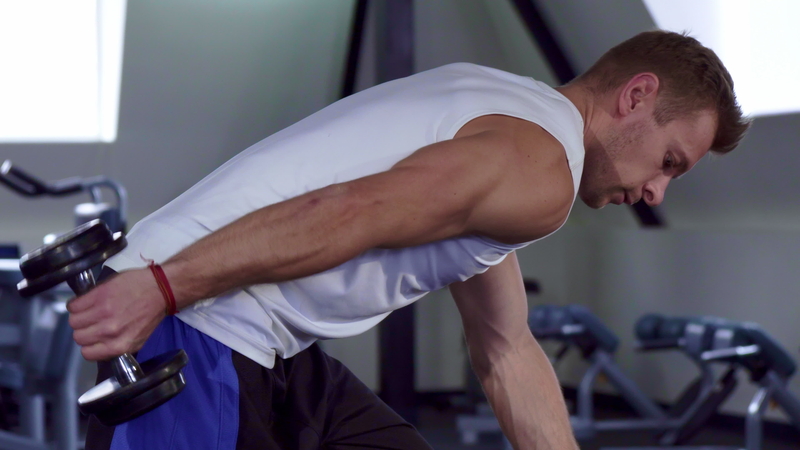
SHOULDERS:
Shoulder Raises (Front)—stand with your feet about hip-width apart. Grab a dumbbell in each hand, palms facing your body. Raise your right arm straight up and in front of your body until the dumbbell is about eye level. Pause, hold, and return to the start. Repeat on the opposite side to complete one full repetition.
Shoulder Raises (Side)—just like above, perform the same movement yet raise your arms out to the sides instead of the front until your hands are in line with your shoulders. Pause and return to the start.
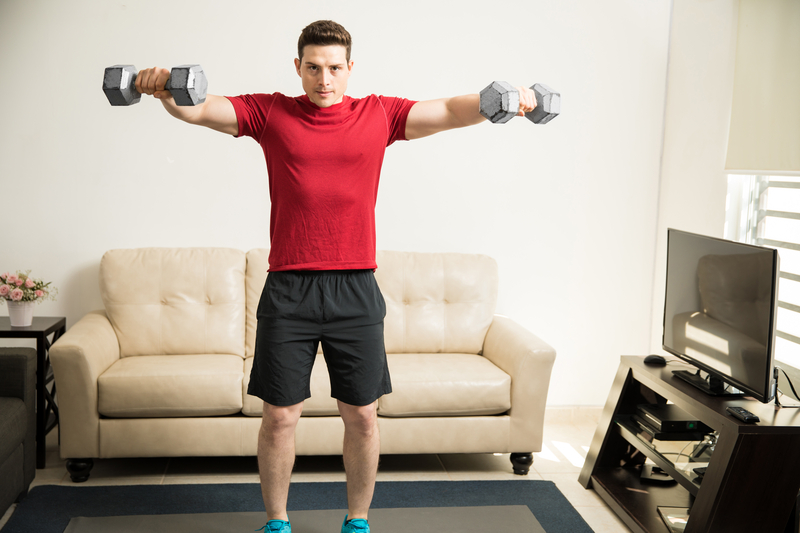
BACK:
Lat Pulldowns—use a band to perform this exercise. You’ll need to anchor your band somewhere above your head that will allow you to get a good stretch when you extend your arms. With an end of the band in each hand, step back or kneel until you feel tension in the band. Next, pull your elbows back and down until you feel the muscles in your back working. Slowly raise your arms back to the start and repeat.
RELATED: Ditch the Glucosamine for Joint Issues. Try These 3 Must-Have Joint Nutrients Instead
Stability Ball Supermans—you can also do this exercise on the floor without the stability ball. Lie with your chest on the top of the ball (or on the floor) with your legs out straight behind you for balance. Stretch out your arms to each side or above your head and arch your back, holding this position for a count of 10. Release and repeat.
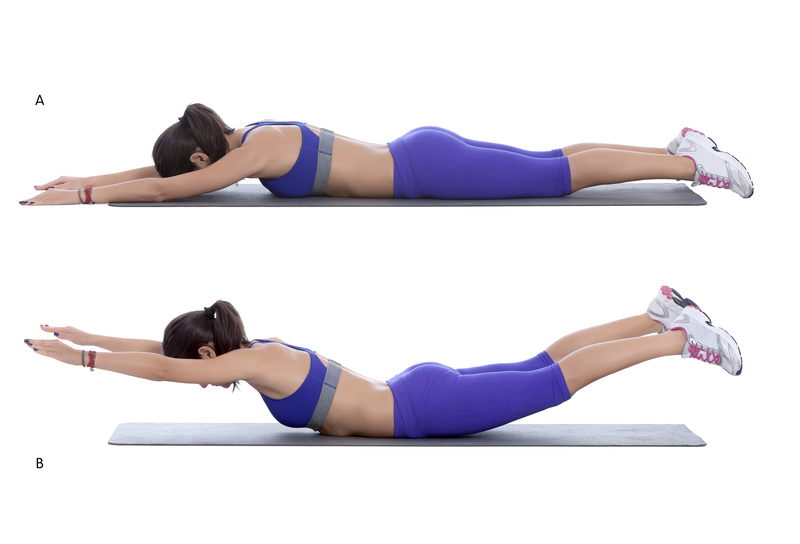
BICEPS:
Biceps Curls—you can use a resistance band or light dumbbells. Begin by standing with your feet about hip-width apart. If using a band, grab one end of the band in your right hand and place the other end under your right foot. Otherwise, pick up a dumbbell. With your palm/fist facing forward, bend your arm, bringing your hand up toward your shoulder, and squeeze the biceps. Return to the start and repeat. Switch to the opposite side when done.
LEGS/CALVES:
Glute Bridges—begin by lying on your back with your legs bent and your heels placed under your knees. With your arms by your sides, palms down, raise your hips up toward the ceiling as far as you can (by squeezing your glutes). Hold this position for a count of five and return to the starting position to complete one repetition.
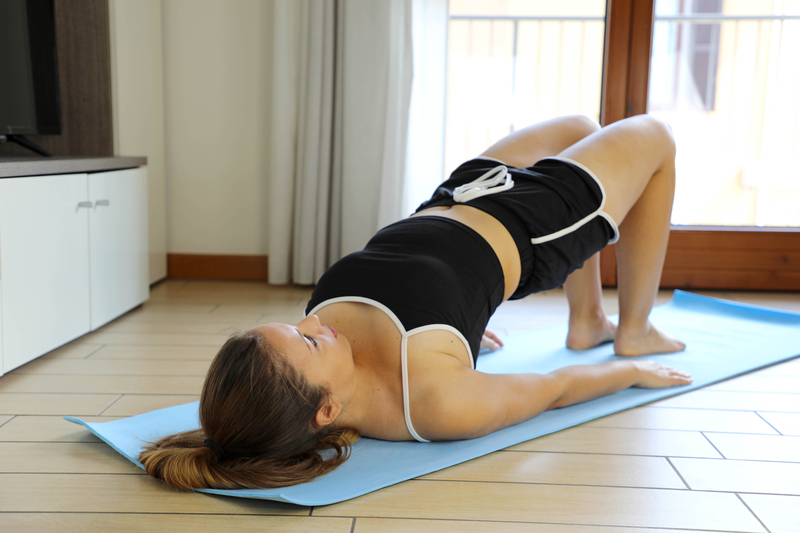
Walking Lunges—stand with your feet about hip-width apart. You can place your hands on your hips for balance or hold a dumbbell in each hand to make the exercise more challenging. Take a giant step forward with your right leg. Bend at the knees until your legs are bent at about a 90-degree angle. Pause and then push off through the heel of your left foot to propel yourself back to the standing/start position. Repeat on the opposite side to complete one full repetition.
Wall Squats—stand against a wall and scoot your feet out about two feet away from the wall (so when you bend your knees, your thighs are parallel with the ground). Place your hands straight out in front of you or on your hips. Press your back against the wall and lower your hips until you are in a “seated” position and hold.
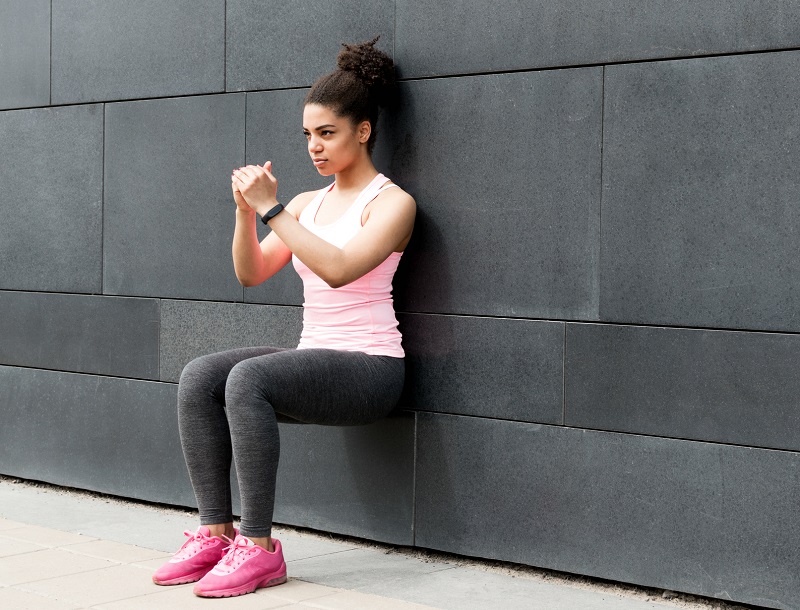
Calf Raises—hold onto a railing while standing with your toes on the edge of a stair and your heels off the edge. Slowly let your right heel drop down past parallel until you feel a good stretch in your calf muscle. Then, squeeze your calf to bring your body up onto the toes of your right foot. Repeat 10 times for the right side and 10 times for the left side.
Calf Raises with weight—for a twist on the original, try holding a light dumbbell in each hand as you go up onto your toes and then lower yourself back down again.
ABS:
Planks—the plank is one of the most common and effective abdominal exercises. This popular move works to strengthen the entire body while helping you stabilize your body by using your core. Kneel on a mat and move into a pushup position by stretching your legs straight out behind you and getting up onto your toes. Next, lower your upper body down onto your forearms, so your palms are flat on the ground with your elbows aligned below your shoulders. Your back should form a straight line from your head down to your heels. Hold this position for 20 seconds. Release by going back to resting on your knees.
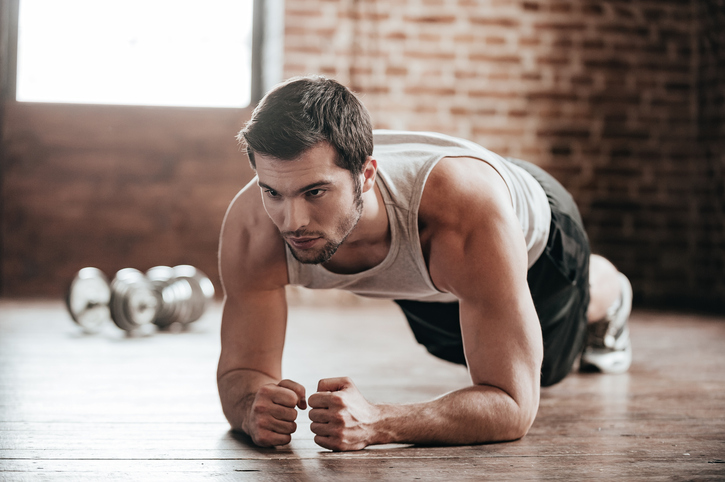
Leg Raises—for this exercise, you’ll start on your back with your legs straight and your arms by your sides. Point your toes and keep your feet together as you raise your legs off the ground about six inches. Make sure not to arch your back as you do this movement. Hold for a count of five and return to the start.
What Kind of Cardio Should You Be Doing?
As mentioned, you’ll be adding cardio into your program on the days when you’re not doing resistance training. During Week 1, do 20 minutes of cardio on the days in-between your resistance training days. During Week 2, up that amount to 30 minutes. During Week 3, go to 40 minutes, and at Week 4, top out at a 45-minute cardio session on non-resistance training days.
Tip: If you’re interested in burning a little extra body fat, you can also add 20 minutes of cardio to the end of your resistance workouts.
You can get in your cardio however you like as long as you raise your heart rate to the point where it’s tough to talk, but you’re not completely out of breath. Walking, jogging, biking, hiking, dancing, and swimming are all great choices.
Finally, don’t forget to cool down and stretch after each workout—resistance or cardio.
Some Diet Basics to Maximize Success
You’ve undoubtedly heard the adage, “you can’t out train a bad diet,” and nothing could be more on point. It’s important to keep your calories in check if your goal is to lose body fat. It’s also important to get your calories from the right sources—sources that will support fat loss and muscle building.
Protein—a portion is about the size of your palm. This will be about 20 – 30 grams of protein. Choose organic, free-range, grass-fed, and pastured food choices for the healthiest options. If you can’t get those, then aim for lean meats, poultry, and fish.
Healthy fats—a portion will be about the size of your thumb. Healthy fats come from sources like raw seeds, nuts and nut butters, avocado, and olive and coconut oil.
Veggies—choose fibrous veggies like greens, celery, yellow squash, zucchini, cauliflower, broccoli, and green beans.
Complex carbs—yams, sweet potatoes, brown rice, quinoa, and oatmeal are all great carb choices. Add these to one meal per day, preferably right after your resistance training workout.
For more information on dieting and diet plans, check out our blog on the 27 Best Diets for Weight Loss, which links to articles on just about any diet you might be considering.




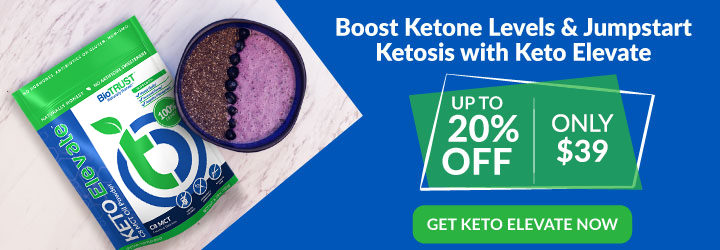

 7 Signs Your Body is Seriously Low on Collagen (not just wrinkles)
7 Signs Your Body is Seriously Low on Collagen (not just wrinkles) Health Expert: "Turmeric Doesn't Work (unless...)"
Health Expert: "Turmeric Doesn't Work (unless...)" 3 Warning Signs Your Probiotic Supplement is a Total Waste
3 Warning Signs Your Probiotic Supplement is a Total Waste

